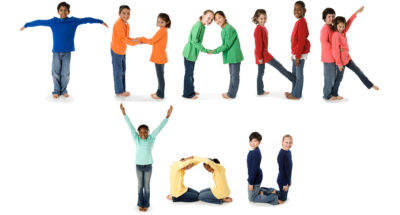Instructions
Saying “Thank You”
- Ask the class:
- Think of someone that you said “Thank you” to recently.
- Take a few moments to think about this silently.
- Now turn to a partner and talk about who you thought of and why.
- When pairs have finished speaking, ask:
- Who can share an example of a time you said “Thank you” to someone, and why?
- Does anyone know what the word “gratitude” means?
- Explain that “gratitude” refers to the feeling we have when we appreciate other people for being kind, or for doing caring things. Give an example of your own life, such as: “I feel grateful when someone held the door for me this morning because I was carrying heavy bags.”
- Discuss how we can also feel gratitude when we appreciate tangible things that we have, things that someone gives us, or things that are part of our daily life that we may not give much thought to. Give an example from your own life, such as: “I felt grateful for my dinner last night, because I was really hungry and it was delicious.”
- Demonstrate how many people also feel grateful for things in the natural world. Give examples of this, such as: “I feel grateful for the rain that gives us water to drink, and helps plants grow.”
- Discuss how sometimes we feel gratitude for things we cannot directly see or touch, but which are nonetheless important, such as health, our heritage or traditions, fairness, ideas that inspire us, or just being alive. Give another example from your own life, such as: “I feel grateful when I get to learn something new, because learning makes my mind grow.”
- Explain that we often show gratitude by saying “Thank you” to someone. [Note: Some students may come from homes or cultures where verbally expressing gratitude is not the norm. Encourage students to share other ways their family or community may express gratitude.] When we feel gratitude, we say that we are “thankful” or “grateful.”
Gratitude Activity
- Give a sticky note to each student. Ask them to jot down a short note about a time they felt grateful and what they were grateful for, or who they were grateful to (this may be the same idea that they shared, or a new one).
- Point out the four signs in the four corners of the room. Tell students:
- Look at your sticky note, and think about which of the four signs, “Things We Own,” “Kind Actions,” “Nature,” and “Other Important Things,” best describes what you wrote.
- Move silently and stand near the sign that describes your idea.
- If your idea doesn’t match one of the signs, stand in the center of the room. Any students in the center may come up with a new category.
- Share what you wrote within your group.
- If there is only one student in the center of the room, ask them to share what they wrote and the new category. Discuss the new gratitude category as a class.
- Ask for one or two volunteers from each group to give an example of the type of gratitude indicated by their sign or new category.
- When examples from each group have been shared, tell the groups to move together clockwise to stand next to a new sign. Have students again discuss things that they feel grateful for that would be described by this new sign (they do not need to write these down). Ask for an example or two from each group.
- If time allows, continue the clockwise rotation until everyone has moved through all four (or five) stations.
- Discuss:
- Which examples were easy to think of? Why might that be?
- Which examples were hard to think of? Why might that be?
- What examples of gratitude did you hear that surprised you?
- What did you learn about gratitude from this activity?
Closure
- Ask students to reflect on how it felt to think about things or people they are grateful for. How might they encourage others to practice gratitude
Extensions
- Have students write a paragraph or draw an illustration of what they are grateful for. Post these on a bulletin board.
- Encourage students to look at any tangible “things” that were discussed. Who are the people who gave them those things? Think about the people that helped to make them. Include those people in your gratitude!
Source
“Nurturing Gratitude From the Inside Out: 30 Activities for Grades K–8” was originally developed by The Inner Resilience Program, in partnership with the Greater Good Science Center and the John Templeton Foundation.
For the entire curriculum, click here.



Comments